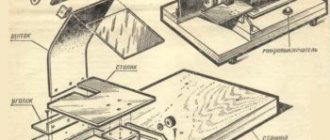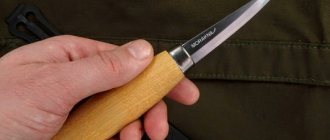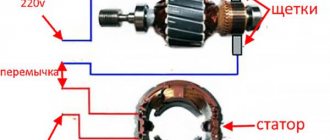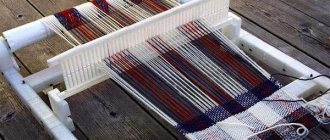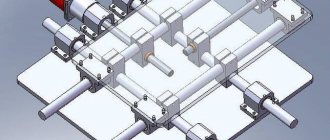You can sharpen a dull knife yourself without going to a workshop and wasting money - you just need a grinding stone and a steady hand. The difficulty is that it is not easy for a person without experience to maintain the angle of the blade in relation to the abrasive stone, and without this the knife can be damaged: bent, twisted or dulled even more. It is more convenient to restore the sharpness of the cutting edge with a device that can be easily made in 2 hours from scrap materials - those leftovers that can be found on the balcony, in the garage or shed. A DIY knife sharpener can be either a primitive system or a complex functional unit.
A knife sharpening device will make your work much easier.
A simple device for sharpening knives
The simplest device for sharpening knives is based on the use of an angular frame and a whetstone. The price of such a primitive factory-made device is quite high, as is the price of replaceable whetstones, but making such a device for sharpening knives at home will not be difficult for a craftsman. You will need the following equipment:
- Wooden blocks of the same size - 4 pcs.
- Drill (or any other drilling tool).
- Bolts and nuts (about 4 pieces each).
- Touchstone.
- Protractor.
First you need to make a pair of wooden corners, placing the bars to each other strictly at an angle of 90º (Fig. 1). Close the resulting wooden corners together parallel to each other as a single whole and drill holes through the diameter of the bolts. Insert bolts into the holes and tighten the corners slightly with nuts.
The simplest device for sharpening knives
The point of this invention is that it is possible to sharpen simply by holding the knife vertically in relation to the sharpening surface located at a given angle.
The most important thing is to properly secure the whetstone between the wooden corners of the device. To do this, using a protractor, you need to set the desired angle of inclination of the touchstone and tighten the bolts tightly to clearly fix the position of the touchstone.
With some modification of the device, you can also fix the position of the knife relative to the sharpening stone. A significant disadvantage of such a machine for manual sharpening is the inability to smoothly adjust the angle of inclination of the sharpening stone.
L.M.
How to make a knife with your own hands at home
The use of a manual knife sharpener such as Lansky-Metabo, pos. 1 in Fig. The diagram of its device is given in pos. 2, and the procedure for use is in pos. 3. The disadvantage of the Lansky-Metabo sharpener is the instability of the sharpening angle along the length of the blade: a rod with a touchstone is driven along it. The offset of the touch point is constantly changing, because it describes an arc of a circle, and the blade has a different configuration. Resp. The angle also “floats”. Therefore, the Lansky-Metabo sharpener is used primarily for sharpening camping and hunting knives with a relatively short blade.
Knife sharpener type Lansky-Metabo
However, this disadvantage can be turned into an advantage if the blade is clamped in the terminals with the root part A (at the handle) and the tip slightly turned away from you, pos. 4. Then the sharpening angle at the root of the blade will be greatest, which is optimal for processing hard materials or using the knife as a cleaver. This is how they work in such cases, so that the outer arm of the arm-blade lever is shorter.
Towards the middle of blade B, the sharpening angle will gradually decrease and reach a minimum at the bend of its generatrix B1, which is convenient for fine work. Then towards the tip the B angle will increase again, making the tip more resistant to drilling, chiselling/impacting and punching (piercing).
Drawings of parts of the original Lansky-Metabo sharpener are given in Fig. The numbers at the windows under the rod (guide) correspond to FULL sharpening angles.
Drawings of Lansky-Metabo knife sharpener parts
On the trail. rice. An assembly drawing of the clamp is given, and then there are drawings and dimensions of Lansky-Metabo terminals made from angle 90x90x6 mm. The author of the development hides under the pseudonym Serjant. This is certainly a matter of his modesty. But, by the way, in production, technological innovations that make it possible to use standard profiles for the manufacture of shaped parts are sometimes valued more than serious inventions.
Assembly drawing of a Lansky-Metabo knife sharpener clamp
Drawings of homemade terminals for a Lansky-Metabo sharpener from a 90x90x6 corner
General assembly drawing of the Lansky-Metabo knife sharpener
Device for sharpening from mounting angles
The diagram and drawings of a homemade knife sharpener made from mounting angles, based on a Lansky device, are clearly shown below.
Diagram of a homemade sharpener made from mounting corners
To assemble this device you will need:
- Metal corners 90*90 mm with a wall thickness of 6 mm.
- Stud with M6 thread and length 160 mm.
- Thin rod (electrode, knitting needle, etc.).
- Touchstone.
- 2 rectangular pieces of metal (sponges for clamping the whetstone).
- Pliers.
- Hacksaw for metal.
- File (or any other tool for processing sharp corners).
- Set of hardware (nuts and bolts).
Drawing of clamping jaws of a Lansky type device
Drawing of clamping jaws of a Lansky type device
Holes should be made in the metal corners and threads cut into them according to the drawings. Then grind off the bevels on the jaws that secure the knife blade in order to prevent interference with the movement of the whetstone. All sharp corners and edges of the future sharpening device must be processed with a file.
Diagram of a finished sharpening device made from mounting angles
In both metal jaws intended for fixing the keystone, you need to drill holes and cut a thread for the connecting bolt. Fix the touchstone. A thin smooth knitting needle, previously bent at an angle of 90º, must be inserted and secured in the hole of one of the jaws. In the future, using this knitting needle-shaped clamp, a certain angle of inclination of the touchstone will be set. Such a device for sharpening knives is characterized by a wide range of sharpening angles, which will undoubtedly be of interest to most craftsmen.
Locking blade machines
Knife sharpening machines with locking blades will attract the attention of those people who want to sharpen a knife not only efficiently, but also quickly. The design, which rigidly fixes the knife blade relative to the sharpening stone moving at a set angle, allows you to accurately set the angle of inclination.
To create such a homemade machine with your own hands you will need:
- The base is a rectangular wooden plate with dimensions 440*92 mm and a thickness of 18 mm.
- Wooden die 92*45*45 mm (for fixing the vertical threaded rod).
- A wooden block 245*92 mm and 18 mm thick (the plate to which the knife will be attached).
- Iron plate 200*65 mm and metal thickness 4 mm.
- Piano hinge, 92 mm long.
- M8 hairpin 325 mm long.
- Nuts and bolts with M8 thread.
- Drill 6.5 mm.
- M8 tap.
- Self-tapping screws 50 mm, 4 pcs.
The die intended for fixing the vertical threaded rod must be drilled through with a 6.5 mm drill. The hole should be located at a distance of 15 mm from the edge of the die, approximately in the center.
Layout of the hole in a wooden die
Next, in the resulting hole you need to cut a thread for an M8 stud. The wooden block prepared in this way must be screwed to the base at a distance of 265 mm from the edge using ordinary self-tapping screws 50 mm long, screwed into the back of the base.
Determining the location of the bar attachment
Screw location diagram
After the block and the base are securely fastened, you need to insert an M8 pin into the hole in the block. The pin should run across the entire cross-section of the beam and the base; thus the risk of changing its position is minimized. The pin at the base of the block must be firmly fixed with an M8 nut, slightly recessed when twisting it into the wood of the block.
The second part of the work involves assembling a clamping device to fix the position of the knife. To do this, a piano loop is attached to a block of wood 245*92 mm with three self-tapping screws from the end of the wooden plate, with the help of which it will be attached to the base of the device.
Attaching the fixing bar to the base using a piano loop
After securing the wooden part of the holding device, you can begin to attach the iron plate. In the center of the 200*65 mm plate, you need to drill an oblong groove, 90 mm long and about 1 cm wide. The groove should be located from the edge of the clamping plate at a distance of 60 mm. Additionally, you need to drill a hole at a distance of 20 mm from the opposite edge and cut a thread in it for an M8 bolt. Then you need to attach the clamping plate to the previously prepared wooden base using this bolt. Using another bolt and a suitable washer, you need to fix the clamping plate in the center of the cut groove. The fixation should be clear, but at the same time neat, so as not to damage the surface of the blade.
Attaching the Iron Clamp Plate
The most difficult part of assembling this device is preparing the control device that will set the sharpening angle of the knife. For this you will need:
- metal square profile 40×40 mm;
- furniture bracket, 40 mm wide;
- a pair of rivets;
- a piece of plywood 42×25 and 18 mm thick;
- bolt and nut M5;
- a pair of M8 wing nuts;
- whetstone;
- steel bar with a diameter of 0.8 cm and a length of 40 cm.
It is necessary to drill a couple of holes on a piece of plywood: a through hole with a diameter of 8 mm along a cross-section of 42×18 mm (the distance from the edge on the 42 mm side should be set at 15 mm) and a through hole with a diameter of 5 mm along the side with a cross-section of 42×25 mm (the distance from edges 10 mm). The square pipe should be cut in half so that you get a “U”-shaped bracket with a width of 40 * 15 mm and ears of 20 mm. You need to drill 8 mm holes in the ears, into which an M8 pin will later be inserted. Connect the resulting bracket to a furniture hinge using rivets. Using the second part of the furniture bracket, attach a block of plywood to the resulting structure with an M5 bolt.
Location on the spoke of the guide mechanism
Connect the touchstone to a guide rod, which is a steel rod with a cross-section of 8 mm. When connecting the keystone and the guide rod, you should strictly ensure that their center lines coincide. If desired, for ease of use of the sharpener, a handle-holder can be attached to the whetstone on the reverse side. All that remains is to secure the whetstone in the guide mechanism, secure it with a thumb and the homemade device for sharpening knives is ready.
Sharpener assembly
Why do you need a sharpener?
A living relic of our days is the Finnish hunting knife. Not a gangster Finnish knife, sometimes of a bizarre shape, but a Finnish-type hunting knife, on the left in the figure. Traditional hunting knives (center and left) are similar in shape, but the difference between them is very large.
Finnish knife and classic hunting knives
The blade of a Finnish knife is forged from cast iron, which can be smelted right in your yard from swamp ore in a furnace-furnace, without resorting to the blast furnace process, puddling, and other methods of converting cast iron into iron and steel. The viscosity of crinkly iron is excellent; it is very difficult to break a blade made from it. But the hardness is also low, somewhere around HRS55, the knife becomes dull quite quickly. Finnish hunters did not care about this: a blade of such hardness can be sharpened (sharpened) by beating on many natural stones, and there were always enough smoothed moraine boulders in Fennoscandia.
They sharpen a knife by beating it in much the same way as beating a scythe, only the whetstone is motionless and the blade is moved. First, they pull it along the whetstone with the butt away from you, then they turn it over and pull it with the butt towards you. The position of the cutting edge (CR) on the whetstone is always dragging; quick movements: shirk-shirk! During each movement, you need to keep the contact patch of the blade with the touchstone (see below), but the requirements for maintaining the angle of inclination are not so strict. Learning to sharpen a knife by beating is not very difficult, and with some skill you can create a smoothly running profile on the blade, see below. However, the Finnish knife is, in general, a dead end in the evolution of a cutting tool, surviving in special natural conditions.
A good knife has never been cheap, and in extreme situations, the durability of the blade, combined with the toughness of the blade, became vital factors. Therefore, even in ancient times, they learned to harden knife blades from the surface and cement them: the core remained viscous, not brittle, and a hard, red-hot crust formed on the outside, see next. rice.:
Structure of a knife blade with surface hardening and carburization
It is still possible to sharpen a knife with a cemented blade, but you need a skill that is not given to everyone. And the abrasive is already needed from a special type of stone - lithographic grunstein slate. There is little of it in nature; Grünstein is still considered a strategic raw material. There is no artificial grenstein and it is not expected. It’s as easy as shelling pears to ruin a cemented knife with inept beating - a little somewhere the cementation bark will be stripped down to raw metal (this is not visible to the eye), the knife will only have to be thrown away, the blade will immediately become dull and begin to crumble.
Service knives do not require the same durability and toughness as hunting and hiking knives, and they should cost much less. As a result, special steels and powder metallurgy are widely used in the production of utility knives. The blade of an “eternal” kitchen knife is structured like a rodent’s incisor: in longitudinal layers, the hardness of which decreases from the core outward. In any case, you have to sharpen the knife less often, but chipping is definitely ruled out - the blade immediately becomes discolored.
Machines with fixed sharpening surfaces
Machines with fixed sharpened surfaces are a simple modification of the device for processing household knives. In such a device there is no possibility of adjusting the sharpening angle, but you can pre-set several different angles for sharpening different types of knives. The work of sharpening blades using such machines is not difficult; you just need to move the blade along the abrasive surfaces in the recess.
The device consists of a pair of planes inclined to each other at a certain angle, one of which is a grindstone.
Electric knife sharpeners
The procedure for creating an electric sharpening machine is simple: it is enough to equip almost any device for sharpening knives and scissors with an electric drive. Such a sharpening machine allows you to quickly and efficiently sharpen the product and at the same time provides a better concave shelf at the edge of the blade.
The mechanism of an electric sharpener for sharpening knives contains a guide, which is located along the axis of rotation of the sharpening stone, and with the help of which the blade is adjusted at a given angle. The sharpening angle is set and set by the guide, and the clamping force is determined by the master.
Particular attention must be paid to the speed of sharpening, because... The electric drive allows you to sharpen the product at high speed, as a result of which the surface of the knife heats up. Such surface heating leads to tempering of the hardened steel, as a result of which the knife can quickly lose its hardness and its service life will be noticeably reduced. To prevent tempering of the steel, sharpening should be done on a high-speed electric sharpener in short periods of time and with sufficient breaks to allow the knife to cool.
Basic mistakes
As it may seem at first glance, sharpening is simple, but if you delve into the process itself, you will notice a fairly large number of different nuances. Most people make simple mistakes when sharpening knives, which leads to uneven sharpening or damage to the knife. Common mistakes when sharpening:
- The cutting edge was not sharpened . As a result, small burrs form on the sides, which temporarily give sharpness to the blade, and after working with the knife for a short time, the blade again becomes dull. To prevent this problem, you should carefully sharpen both edges, and then, as you sharpen, use sandpaper or a wheel of different grits.
- Presence of paint, oil, dirt on the tip . The bottom line is that during turning, fat, dirt, oil and other components mix with grinding abrasives and lead to scratches and microchips of the blade. After such sharpening, the blade quickly becomes dull.
- Pressure plays an important role . You need to remember one simple rule: sharpness does not depend on the force used, but on the duration of sharpening. Excessively strong pressure leads to chipping of microparticles from the blade and poor sharpening.
- Wrong choice of angle . The angle may vary depending on the grade of steel and the purpose of the tool. For home kitchen knives it is 20 - 25 degrees. For other types of blades that will have to withstand heavy loads and work with hard materials, the angle will be 40 degrees.
Making sharpening stones
It will not be difficult for a modern craftsman to make sharpening stones with his own hands. For this you will need:
- a wooden die to the size of the future sharpener;
- epoxy resin;
- cardboard boxes according to the size of the block;
- abrasive;
- protective rubber gloves.
You can use ready-made powder as an abrasive, or you can prepare your own abrasive, for example, from an old Soviet-made green block. Such a block can be ground into powder and used in the future as an abrasive.
Knife sharpening device
The wooden die needs to be treated on one side with sandpaper and frequent cuts must be made with a saw. Mix epoxy resin with abrasive chips. Having previously placed the block in a cardboard box glued to the size of the block, cover the prepared surface of the wooden block with a mixture of epoxy resin and abrasive. Once the resin has completely cured, the block is ready for use.
Another option for making your own sharpening stones is to create a sharpening stone from small rectangular glass plates about 5 mm thick. Using double-sided adhesive tape, sandpaper is glued to the surface of the glass plate. The sharpening stone is ready for use.
Methods for checking the blade tip
After carrying out the work, you need to check how sharp the blade is. Several methods are used for this.
On paper
Try to cut a sheet of paper while holding it with one hand. If you can do it without problems, the sharpening is good. A sharp blade will cut the sheet under its own weight.
On a tomato
Often the sharpness of kitchen blades is tested on tomatoes. If it is blunt, the vegetable will be crushed. You need to put it on the table in front of you, try to cut the tomato with the blade horizontally without holding it with your hand. A sharp blade will easily cut a vegetable.
Checking knife sharpening on tomatoes
Device for sharpening from wooden blocks
A simple device for sharpening knives is a tool consisting of a pair of wooden slats and a pair of abrasive bars with the same geometric dimensions.
Wooden slats should be thoroughly sanded with abrasive sandpaper. Then, after applying auxiliary markings, depending on the sharpening angle of the knife, make cuts to a depth of 15 mm. Insert sanding blocks into the resulting holes so that each groove matches, then secure them with bolts. To give the sharpening device greater stability, the lower part of the surface can be padded with a piece of rubber.
The types of devices for sharpening cutting tools are different and each master will be able to choose the manual machine that will fully satisfy his needs.
